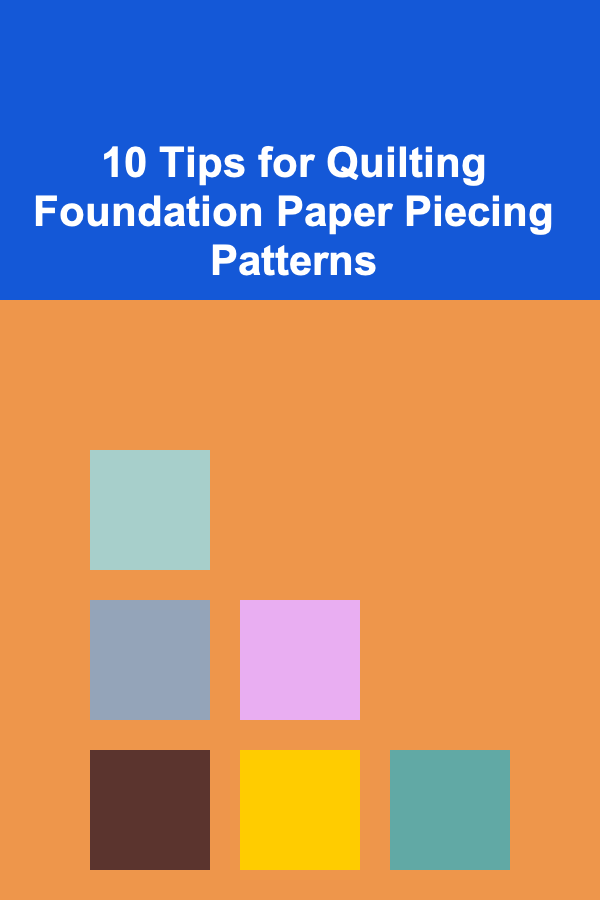
10 Tips for Quilting Foundation Paper Piecing Patterns
ebook include PDF & Audio bundle (Micro Guide)
$12.99$10.99
Limited Time Offer! Order within the next:

Foundation Paper Piecing (FPP) is a method of quilting that allows quilters to create precise, intricate designs that might be difficult to achieve through traditional piecing techniques. This method uses a printed paper foundation as a guide to sew fabric pieces onto the pattern. The result is a beautifully detailed quilt with sharp points, perfect for those who love precision and challenge in their craft.
However, for many quilters, Foundation Paper Piecing can seem intimidating at first. The process of piecing together small pieces of fabric and sewing through paper can feel cumbersome, but with the right tools, techniques, and mindset, FPP can become one of your favorite quilting methods. In this article, we'll explore 10 tips for quilting Foundation Paper Piecing patterns, so you can master this method and create stunning quilt designs.
Choose the Right Paper for Your Foundation
The foundation paper you choose plays a vital role in your FPP success. The paper needs to be thin enough for easy removal after stitching, yet sturdy enough to withstand multiple layers of fabric and sewing. There are several options available, including:
- Specialty FPP Paper: This type of paper is specifically designed for Foundation Paper Piecing. It is lightweight and tears easily, yet still provides enough structure for accurate piecing.
- Regular Printer Paper: This is a cheaper option and often works well for smaller projects. However, it can be slightly thicker and may be harder to tear away once the quilt is finished.
- Tracing Paper: Some quilters prefer tracing paper for FPP because it's very thin and easy to tear, though it may require more care when handling.
Tip:
Test different papers with your pattern to see what works best for you. If you use regular printer paper, you might need to adjust your sewing machine's tension slightly to prevent the fabric from bunching.
Accurately Print Your Pattern
Ensuring that your pattern is printed at the correct size is crucial in FPP. A common issue many quilters encounter is that the printed pattern may not be to scale, causing problems when the pieces are pieced together.
How to Ensure Accuracy:
- Check the Print Settings: When printing, make sure your printer settings are correct, and that the "scale to fit" option is not selected. If possible, use a pattern that has a test square printed on it for you to measure after printing.
- Use a Ruler: Measure the printed test square to confirm it's the right size before cutting out the pattern pieces.
Tip:
If you're unsure whether your printer is printing at the correct scale, you can also try printing a small section of the pattern and measuring it against the original dimensions. This can save you from making mistakes later.
Start with Simple Patterns
Foundation Paper Piecing can be overwhelming at first, so it's a good idea to start with simple patterns that don't require too many fabric pieces or complex shapes. Many beginners start with geometric shapes or blocks like squares, rectangles, or simple stars.
Simple Patterns to Try:
- Basic Geometric Shapes: Triangles, squares, and diamonds.
- Simple Blocks: A basic log cabin block, or simple star blocks like the Sawtooth Star or Pinwheel.
Tip:
Don't jump straight into intricate patterns with small pieces until you feel confident with FPP basics. Starting with a manageable pattern will help build your confidence.
Press Your Seams as You Go
One of the biggest challenges with FPP is that the seams can become bulky and difficult to press flat if you aren't careful. To avoid this, it's essential to press your seams as you go, but also use the correct technique to avoid distorting the fabric.
How to Press Your Seams:
- Press After Each Piece: After sewing each fabric piece to the foundation paper, press the seam open or to one side to ensure it lays flat.
- Use a Mini Iron: A mini iron is especially helpful in FPP because it can fit into smaller spaces and help avoid over-pressing large sections of the block.
- Avoid Steam: While steam can help press seams flat, it can also cause the paper to soften and be harder to remove. Use a dry iron whenever possible.
Tip:
To minimize bulk, trim your seam allowances to a quarter-inch after pressing the fabric. This will reduce the overall thickness of the quilt and make piecing more manageable.
Use a Smaller Stitch Length
A smaller stitch length is essential for Foundation Paper Piecing. Smaller stitches (around 1.5-2.0mm) will make it much easier to tear the paper away once you've completed your block. Additionally, it helps secure the fabric pieces and provides more precise stitching.
Why Smaller Stitches Work:
- Tighter Stitches: The smaller the stitch, the more secure the fabric will be, especially for intricate or tiny sections of the block.
- Easier Paper Removal: Smaller stitches allow the paper to be torn away more easily after piecing.
Tip:
Practice adjusting your stitch length and try testing on a scrap piece of fabric before starting your project. This will ensure the stitches are small enough to be effective without causing fabric bunching.
Cut Your Fabric Pieces to the Right Size
When it comes to Foundation Paper Piecing, precision is key. You'll need to cut your fabric pieces slightly larger than the sections on your pattern to ensure there's enough overlap to cover the entire section. However, cutting too large can result in bulky seams.
How to Cut Fabric Pieces:
- Add a Generous Margin: Cut your fabric pieces with at least a quarter-inch extra on all sides of each section.
- Use a Ruler: A quilting ruler with accurate measurements will ensure you're cutting the correct size pieces for each section of the block.
Tip:
When in doubt, cut your fabric pieces a bit larger than you think you'll need. It's easier to trim down than to add fabric later!
Work in Sections
FPP patterns can often feel overwhelming because they require piecing together small sections. The best approach is to work in manageable chunks. Instead of trying to assemble the whole block at once, divide the design into smaller, more achievable sections.
Breaking Down the Process:
- Sew One Section at a Time: Start with the outer sections of the block, and work your way inward, adding each piece in a logical order.
- Trim Excess Fabric: After each section is sewn, trim the fabric to match the design lines and ensure a smooth, precise fit.
Tip:
Working in smaller sections allows you to focus on one part at a time, reducing mistakes and helping you stay organized.
Use a Needle with a Sharp Tip
Using the right needle is just as important as using the right paper and fabric. A sharp needle will create cleaner, more precise stitches and will help minimize the risk of breaking or fraying the fabric.
Recommended Needle Types:
- Microtex Needles: These are a great choice for Foundation Paper Piecing as they have a thin shaft and a very sharp point, making them ideal for sewing through multiple layers of fabric and paper.
- Universal Needles: For beginners, a standard universal needle can also work, but be sure to choose a size that matches your fabric weight (usually 70/10 or 80/12).
Tip:
Change your needle regularly, especially when working with thick fabrics or intricate patterns, to ensure smooth stitching.
Remove the Paper Carefully
Once you've finished your block, it's time to remove the paper foundation. This can be a tricky process, but with patience and the right technique, it's entirely manageable.
How to Remove the Paper:
- Tear Gently: Start by gently tearing away the paper from the seam line. Do not pull too hard, as this could distort the fabric.
- Use a Seam Ripper: If necessary, use a seam ripper to remove any stubborn paper that's stuck in the seams.
- Avoid Over-Tearing: Be careful not to tear the fabric itself. If you find the paper is difficult to remove, you might need to loosen the stitches a bit first.
Tip:
For easier paper removal, consider using a paper with perforated edges, or spray the back of your fabric with a fabric softener solution to loosen the paper fibers.
Practice and Patience
Foundation Paper Piecing requires a great deal of patience, and like any other quilting technique, practice makes perfect. Don't be discouraged by mistakes or initial challenges. The more you work with FPP, the better you'll get at it.
Ways to Practice:
- Start with Simple Patterns: As mentioned earlier, begin with simple patterns before tackling more intricate designs.
- Use Scraps: Practice on fabric scraps before committing to your main fabric to get a feel for the technique.
- Slow Down: Take your time, especially in the beginning. Speed will come with experience.
Tip:
Enjoy the process! Foundation Paper Piecing is a craft that rewards you with beautiful, precise results. Take your time and savor the satisfaction that comes with mastering the technique.
Conclusion
Foundation Paper Piecing is a rewarding and highly precise quilting method that allows you to create stunning designs. By following these 10 tips, you'll be able to simplify the process, overcome common challenges, and enhance your FPP skills. With patience, practice, and the right tools, you can turn any Foundation Paper Piecing pattern into a beautiful, intricate quilt. So, get ready to dive into the world of FPP and let your creativity soar!
Reading More From Our Other Websites
- [Organization Tip 101] How to Use Digital Tools for Seasonal Wardrobe Management
- [Paragliding Tip 101] Wind Patterns 101: What Every Paraglider Should Know Before Takeoff
- [Gardening 101] Seasonal Seed‑Starting Calendar: What to Plant and When
- [Organization Tip 101] How to Display Your Hobby Collection Aesthetically
- [Home Rental Property 101] How to Handle Tenant Complaints Professionally and Effectively
- [Home Lighting 101] How to Use Motion-Sensor Lights for Enhanced Home Security
- [Home Staging 101] How to Find and Utilize the Best Home Staging Resources for DIY Projects
- [Organization Tip 101] How to Plan for Seasonal Changes in Jewelry Styles
- [Skydiving Tip 101] How an Instructor Turns Your Fear into Thrill: Insider Tips for New Skydivers
- [Scrapbooking Tip 101] Layering Techniques: Mastering Depth and Texture with Scrapbooking Stamps

How to Create a Sustainable Pantry with Eco-Friendly Products
Read More
How to Install Your Own Home Security Cameras Like a Pro
Read More
How to Organize Your Garage on a Budget
Read More
The Importance of Emotional Intelligence in the Workplace
Read More
Developing AR for Automotive Maintenance: A Deep Dive
Read More
How to Choose the Right Golf Club for Your Handicap
Read MoreOther Products

How to Create a Sustainable Pantry with Eco-Friendly Products
Read More
How to Install Your Own Home Security Cameras Like a Pro
Read More
How to Organize Your Garage on a Budget
Read More
The Importance of Emotional Intelligence in the Workplace
Read More
Developing AR for Automotive Maintenance: A Deep Dive
Read More